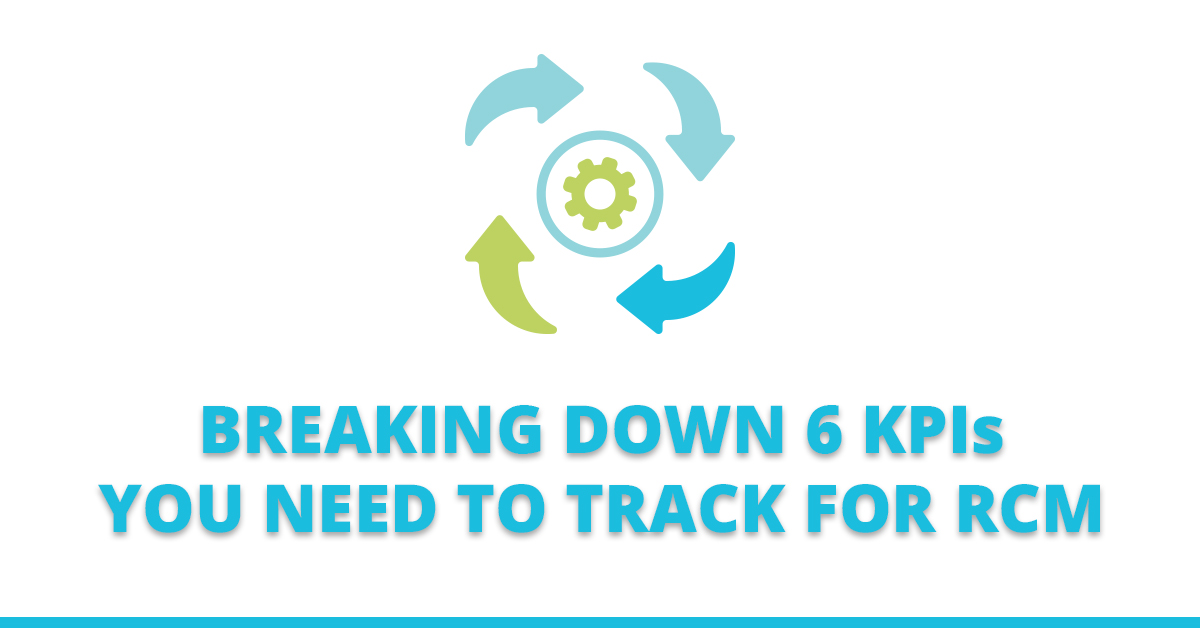
Every successful business enterprise has well-structured systems of operation that support the smooth functioning of the organization. Revenue cycle management (RCM) in healthcare is one such process to monitor every patient’s financial interaction with the healthcare facility – from preregistration to submission of claims, to collection of payments from insurance carriers and patients.
Tracking and managing a revenue cycle is important for the healthcare business’s financial security. Additionally, every organization must also strive to augment the quality of the revenue cycle.
To accomplish that, the organization must set certain trackable goals, like:
- Increasing the point-of-service (POS) cash collections
- Ensuring the generation of clean claims for quick insurance returns
- Lowering the average time taken to get paid for healthcare services
These goals operate as metrics, or revenue cycle KPIs, that can be used as barometers of progress and indicators of possible future actions. In the following sections, let us take a closer look at the best KPIs to track for RCM.
WHAT ARE KPIS
Key Performance Indicators or KPIs are special metrics that help gauge the performance of a company in a revenue cycle. Firstly, to improve the revenue cycle, we must know which factors to monitor. Thus, the HFMA has outlined 27 industry-standard metrics called KPIs or MAP Keys. All competent healthcare businesses regulate these KPIs. Organizations can compare their RCM performance to the benchmarks of the industry for each revenue cycle KPI to ensure they are operating up to the expected mark.
WHY ARE KPIS THE BEST PRACTICE METRIC FOR RCM?
RCM KPIs are calculated uniformly across the board, they are well defined, specific, and trackable. Unlike general metrics, ‘key’ indicators are very specific. Metrics record the overall health of the business and present a historic picture of the company’s performance. Instead, KPIs incorporate goals and objectives and can guide future action for further growth.
The SMART methodology is used to create effective KPIs to track the revenue cycle. According to the outline, KPIs must be:
- Specific
- Measurable
- Attainable
- Relevant
- Time-bound
Administrators and key players in the organization must answer the following questions regarding each KPI to gain a deeper understanding of their goals:
- What is the specific goal?
- How can progress be measured?
- What is the time frame of operation?
- What are the industry benchmarks for this specific KPI? Is the company aiming to meet the standard within the given timeframe?
BEST KPIs TO TRACK FOR RCM
The following 6 HFMA MAP keys are the most important revenue cycle KPIs every organization must be tracking for RCM. (Click here for equations and data extraction sources for each KPI discussed below.)
- POS CASH COLLECTION
Calculation (%): (POS payments / all self-payment receipts) x 100
Industry benchmark: 2%
A point-of-service is the strategic location where customers pay for the services provided to them. POS cash collections are all payments made to the healthcare provider before, at the time of, and up to seven days after services are rendered.
This KPI helps keep a track of POS operations efficiency. Having a high POS cash collection KPI decreases collection costs by collecting maximum payments on-the-spot, expediting the cash flow process.

- CLEAN CLAIMS RATIO (CCR)
Calculation (%): (the number of claims that pass all edits, thus requiring no manual intervention, by the total number of claims accepted into the claims processing tool for billing) x 100
Industry-benchmark: >90%
Often, companies submit claims that are rejected/denied and sent back for revisions. Ideally, claims should be free of error for timely reimbursement, and to prevent further editing hassle. The CCR records the number of average perfect claims that were reimbursed on the first submission, as a fraction of all submitted claims in the given period.
Arguably the most important revenue cycle KPI, this metric pertains to the claim generation stage of a revenue cycle and helps identify and exhibit any problems with the claim submission process. A CCR greater than 95% is indicative of excellent RCM.
- CLAIMS DENIAL RATE
Calculation (%): (Total dollar amount of claims denied / Total dollar amount of claims submitted during the specified period) x 100
Industry benchmark: between 5% and 10%
While the CCR must be maintained above 90%, the claims denial rate must be tracked as well. Claims denial rate shows the number of times the insurance claim is denied due to faulty claims. It must be kept at a minimum to exhibit that the company files clean claims.
This KPI applies to the claim follow-up stage of a revenue cycle. A claims denial rate of less than 5% indicates a prosperous revenue cycle with robust management of the economic flow.
If the claim denial rate is alarmingly high, the company must look into the reasons behind faulty claim submissions. Filing of correct patient information, accurate coding and billing of medical procedures, and verification of the patient’s insurance plan must be completed before submitting claims.
- DAYS in DISCHARGED NOT FINAL BILLED (DNFB)
Calculation: Gross amount in DNFB / average daily gross patient service revenue
Industry-standard: usually 3-5 days
DNFB refers to the incomplete billing of a patient after they have been discharged. The account may be incomplete due to unfinished coding, pending charges, or insufficient service records. This KPI refers to the charge capture stage of the revenue cycle. Naturally, the smaller the time frame for complete documentation, the faster the remittances can flow in. Therefore, healthcare companies must ensure swiftness in capturing the complete picture of all services rendered to a patient to bill them timely.
- BAD DEBT
Calculation (%): (Bad debt / gross patient service revenue) x 100
Industry standard: <3.1%
Debts that cannot be recovered are called bad debts. This includes bills and claims that need to be written off since they will not be reimbursed. Thus, a high bad debt value is indicative of the practice’s incompetence in maintaining a complete revenue cycle. This can be due to ineffective POS cash collections and financial counseling by the healthcare provider.

- DAYS in ACCOUNTS RECEIVABLE (A/R) or REVENUE OUTSTANDING (DRO)
Calculation: Total account receivable / (12 months of gross charges/365)
Industry standard: 30-35 days
This KPI applies to the period between claim submission and remittance processing stages of the revenue cycle. Once a claim has been submitted, the days in A/R exhibit the time that is taken to receive insurance returns.
Financially secure healthcare practices have minimal days in A/R. It is important to track the time taken to get paid for services rendered to maintain a smooth RCM flow. If days in A/R exceed 60 days, the company should inspect the performance of the billing team and claim to follow up practices. With robust communication with insurance companies and filing of clean, first-pass claims, the days in A/R can easily be maintained within industry standards.
See Also: Why Is Reviewing Your Revenue Cycle Process Important And How To Do It.
THE BOTTOM LINE
KPIs are the best practice metrics that can be used to track the revenue cycle. Not only do KPIs give a quantitative analysis of the healthcare provider’s quality of financial administration, but they also set a standard of performance across the board. Since all KPIs are uniformly calculated, analyzing your revenue cycle KPIs and comparing them to a competitor practice’s metrics is fruitful and drives growth within your own company.
Precision Hub offers top-notch medical finance services to ensure that your claim submissions are always clean and promptly reimbursed. If you want to take your RCM to the next level, visit our blog section for more medical administration advice or contact us to avail of our financial services!







No comment yet, add your voice below!